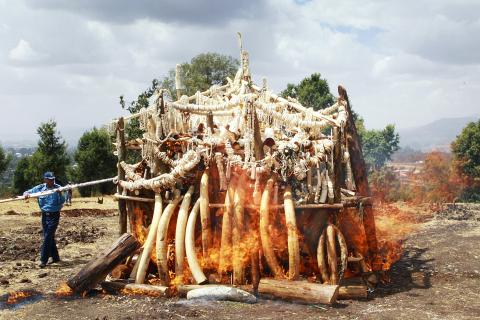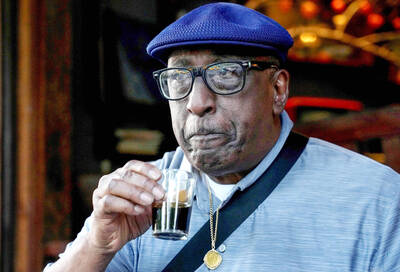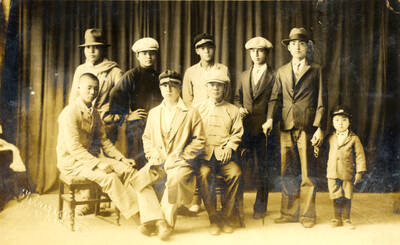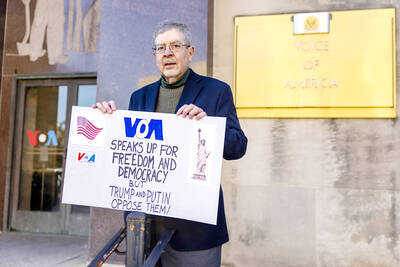Ivory trafficking in Africa, which threatens the survival of elephants, is highly concentrated in a few geographic hotspots and controlled by a powerful few, say scientists who use DNA analysis to track the illegal wildlife trade.
“What was pretty surprising to all of us,” said Samuel Wasser, biology professor at the University of Washington, was “so much of the big trade is focused in one area.”
Speaking at a panel discussion at the annual meeting of the American Association for the Advancement of Science, he said DNA tracking has shown that a small number of kingpins control much of the multibillion dollar illegal trade, and that “these hotspot are very slow to change.”

Photo: EPA/SOLAN KOLLI
Wasser was part of a study published in the journal Science last year that showed for the first time that most of the ivory trade came from two regions of Africa — either a protected zone that extended from Cameroon to Congo to Gabon or eastern Africa, particularly Tanzania.
The most recent analysis on some 200 samples of ivory seized since 2006 shows that traffickers quickly move their take out of the country where the elephants were slaughtered.
DNA analysis has shown that the two tusks of an elephant often show up in separate shipments, suggesting the same dealer is behind both.
“Probably one or two major dealers... are moving all of this ivory out transit out of Mombasa, which the biggest transit area in Africa right now,” said Wasser, referring to Kenya’s second largest city.
DNA analysis has helped crack down on traffickers, though far more needs to be done to eliminate the sophisticated transnational trade.
“Our work has already brought down one of the largest ivory dealers in West Africa and we are now on the trail of probably the largest ivory dealer in Africa,” said Wasser.
Some 50,000 elephants are poached every year in Africa, leaving some only 450,000 elephants across the continent.
LACK OF WILL IN ASIA
Wildlife trafficking is the fourth largest international criminal activity after weapons, drug and human trafficking, experts say.
This illegal commerce brings in a staggering US$20 billion each year, of which three billion is accounted for by ivory.
According to Allan Thornton, president of the Environmental Investigation Agency, even the most advanced forensic techniques have barely made a dent in the illegal trade. “All evidence we have seen is that you cannot manage the ivory trade, it cannot be controlled. It’s too powerful, too valuable,” he said.
“Every effort to try to regulate the trade has been a spectacular failure.”
The only conservation measure that worked was when international trade in ivory was banned for a period of eight years beginning in 1989, he said.
At that time, some 70,000 elephants were killed annually and half the population had been wiped out in the previous decade, going from 1.3 million to 624,000, he told reporters.
During the ban, elephants began to rebuild their population in Africa.
But he said when the ban was partially lifted in 1997 under pressure from Japan, poaching began again in earnest.
A decade later, in 2008, “the endangered species convention allowed legal ivory sales from three southern African countries to Japan and China and after that we saw a massive increase in elephant poaching,” said Thornton.
“But all that time Japan faced very little scrutiny, very little analysis and there has been almost no transparency to that activity.”
Some, like Wasser, say the solution is to crack down on the biggest traffickers.
But William Clark, a retired member of Interpol who worked for many years on illegal ivory trafficking, said Asia needs to step up and change.
China currently makes up about 70 percent of the world’s demand for ivory.
“There is not the political will in Asia to use the [DNA] tools to fight the importers,” he said.
“Asia is not today bearing up to its responsibilities in addressing this problem. The burden is falling on the shoulders of Africans.”

On April 26, The Lancet published a letter from two doctors at Taichung-based China Medical University Hospital (CMUH) warning that “Taiwan’s Health Care System is on the Brink of Collapse.” The authors said that “Years of policy inaction and mismanagement of resources have led to the National Health Insurance system operating under unsustainable conditions.” The pushback was immediate. Errors in the paper were quickly identified and publicized, to discredit the authors (the hospital apologized). CNA reported that CMUH said the letter described Taiwan in 2021 as having 62 nurses per 10,000 people, when the correct number was 78 nurses per 10,000

As we live longer, our risk of cognitive impairment is increasing. How can we delay the onset of symptoms? Do we have to give up every indulgence or can small changes make a difference? We asked neurologists for tips on how to keep our brains healthy for life. TAKE CARE OF YOUR HEALTH “All of the sensible things that apply to bodily health apply to brain health,” says Suzanne O’Sullivan, a consultant in neurology at the National Hospital for Neurology and Neurosurgery in London, and the author of The Age of Diagnosis. “When you’re 20, you can get away with absolute

May 5 to May 11 What started out as friction between Taiwanese students at Taichung First High School and a Japanese head cook escalated dramatically over the first two weeks of May 1927. It began on April 30 when the cook’s wife knew that lotus starch used in that night’s dinner had rat feces in it, but failed to inform staff until the meal was already prepared. The students believed that her silence was intentional, and filed a complaint. The school’s Japanese administrators sided with the cook’s family, dismissing the students as troublemakers and clamping down on their freedoms — with

As Donald Trump’s executive order in March led to the shuttering of Voice of America (VOA) — the global broadcaster whose roots date back to the fight against Nazi propaganda — he quickly attracted support from figures not used to aligning themselves with any US administration. Trump had ordered the US Agency for Global Media, the federal agency that funds VOA and other groups promoting independent journalism overseas, to be “eliminated to the maximum extent consistent with applicable law.” The decision suddenly halted programming in 49 languages to more than 425 million people. In Moscow, Margarita Simonyan, the hardline editor-in-chief of the